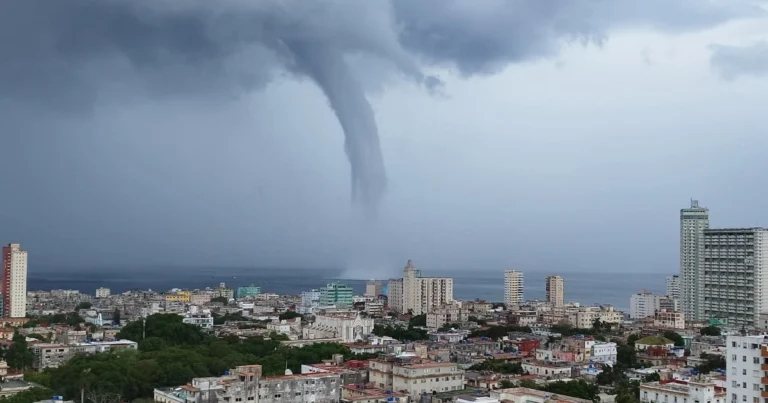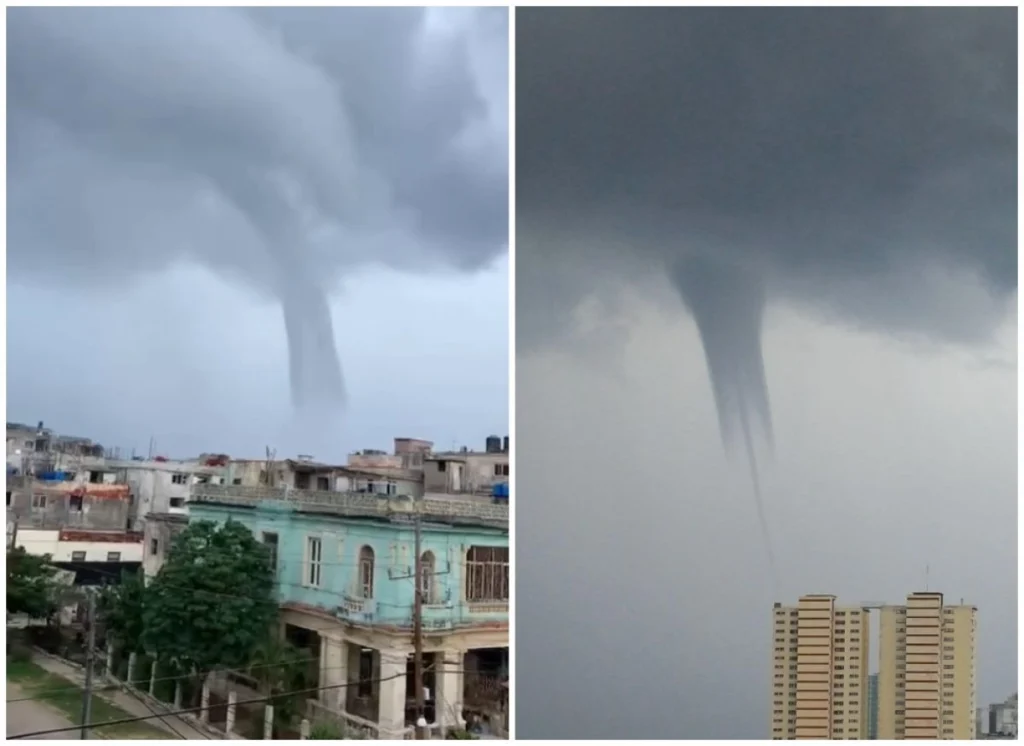Groundbreaking Facts About the Alarming Marine Tornado in Havana 2025

Marine tornado forming over Havana Malecón waters under tropical sky and sunlight, 2025 Photo: Perplexity 8/8/2025
August 8, 2025 Hour: 10:37 pm
Explore the marine tornado sighted in Havana’s Malecón in 2025 — a rare but potentially dangerous weather event with significant coastal and climatic implications.
Related: Elpidio Valdes: Cuba’s Fight For Independence as a Cartoon
Groundbreaking Facts About the Alarming Marine Tornado in Havana 2025
On Friday, a striking marine tornado—also known as a waterspout—was observed off Havana’s Malecón, causing widespread surprise and alerts over its potential danger. The phenomenon dissipated without reported damage. This event occurs when warm, humid air rises over the sea, cools and condenses, generating a visible rotating column of water and vapor.
Marine Tornado in Havana: Understanding the Phenomenon and Its Impact
The recent marine tornado near Havana’s iconic Malecón attracted attention due to its unusual but potentially hazardous nature. Marine tornadoes, or waterspouts, come in two main types:
- Tornadic waterspouts: Tornadoes that form over water or move from land to sea, associated with severe storms and destructive winds exceeding 100 km/h.
- Non-tornadic waterspouts: More common, forming beneath cumulus clouds in relatively calm weather, milder, and typically dissipating upon reaching land.
The Havana waterspout fits the non-tornadic category. It developed amid high temperatures and humidity, typical of tropical coastal zones like Cuba, providing conditions favorable for convective cloud formation and atmospheric instability.
Although generally short-lived and rarely damaging, waterspouts can pose risks to boats and people near shorelines. The event highlights the importance of meteorological surveillance and public awareness in coastal zones.

External Links:
- National Weather Service – Waterspouts
- World Meteorological Organization – Severe Weather Phenomena
- Cuba’s Meteorological Institute (Insmet)
Geopolitical and Climatic Context: Climate Change and Its Impact on Cuba’s Coastal Weather
Cuba is among the nations most vulnerable to the effects of climate change, particularly in relation to coastal and weather phenomena like marine tornadoes. Scientific reports confirm significant environmental shifts:
- Since the 1970s, sea levels around Cuba have risen steadily, with an accelerated rate from 2004 onward, causing erosion and retreat of shorelines by about 1.2 meters per year.
- Ocean surface temperatures have increased by approximately 0.7°C, intensifying atmospheric moisture and heat, enabling more frequent convective phenomena such as waterspouts.
- Freshwater resources have decreased nearly 16% in the last 30 years, with projections indicating a 30-40% reduction by 2050-2100, threatening agriculture and ecosystems.
- There is an increase in extreme weather events: stronger hurricanes, droughts, intense rainfall, and other meteorological hazards.
The Cuban government’s Tarea Vida plan, the country’s state policy for confronting climate change, focuses on adapting to these evolving risks by:
- Strengthening monitoring systems of climatic and oceanographic variables.
- Protecting biodiversity, including mangrove reforestation and coral reef recovery.
- Restricting new constructions in vulnerable coastal areas and promoting population resettlement from high-risk zones.
- Developing agricultural resilience to heat and water stress by introducing resistant crop varieties.
These efforts illustrate Cuba’s proactive approach to minimizing the social and economic impacts of climate change while preparing for inevitable environmental transformations.
External Links:
- IPCC Report on Climate Change and Extreme Weather
- Caribbean Community Climate Change Centre
- UN Climate Change Cuban National Report (UNFCCC)
The Broader Impact of Climate Change on Cuba
The rising sea levels and increased frequency of extreme weather directly impact Cuba’s urban planning, agriculture, economy, and coastal ecosystems. For example,
- Coastal cities such as Havana and Baracoa face risks of flooding and infrastructure degradation. Studies project sea-level rises reaching up to 29 cm by 2050 and nearly 1 meter by 2100, threatening thousands of square kilometers of land.
- Agricultural yields are expected to decline between 10% and 15%, compounded by increased droughts and saline intrusion in coastal farmlands.
- Ecosystem health is declining, with coral reefs suffering bleaching and degradation, impacting fisheries and biodiversity critical to both environment and local livelihoods.
- Public health risks rise with the increased spread of climate-sensitive diseases.
Cuba’s future resilience depends on sustained policies embedding environmental protection, resource efficiency, and community adaptation strategies.

Citizens and Media Role in Climate Awareness
The marine tornado incident was widely captured and shared on social media by citizens and local media. This dissemination has contributed to increased public awareness about rare but meaningful climatic phenomena, reinforcing the need for:
- Enhanced disaster preparedness and education on weather risks.
- Community engagement in climate adaptation and sustainable practices.
- Supporting scientific efforts to monitor and communicate evolving climate impacts.
Author: JMVR
Source: JT - RR -NWS

